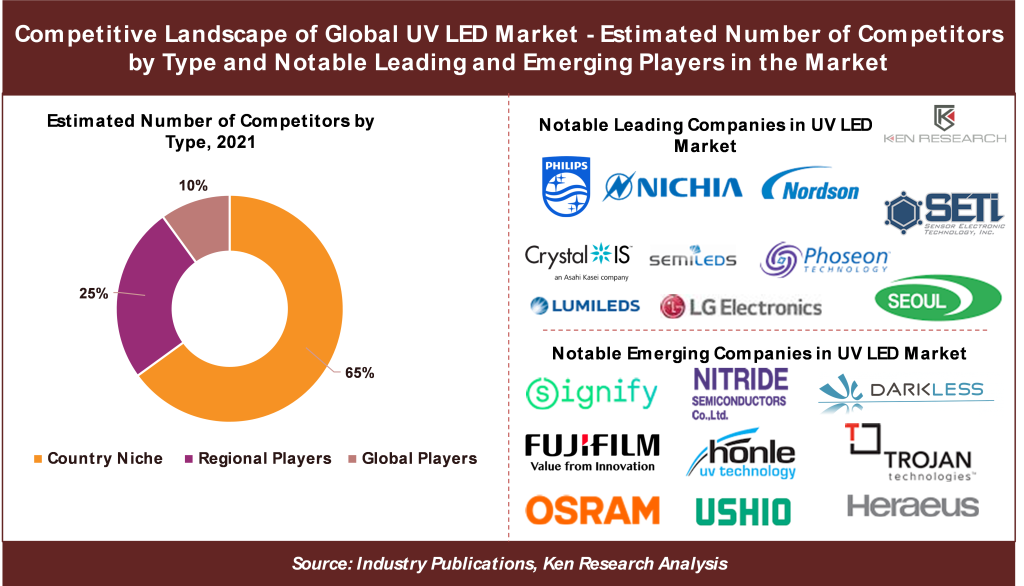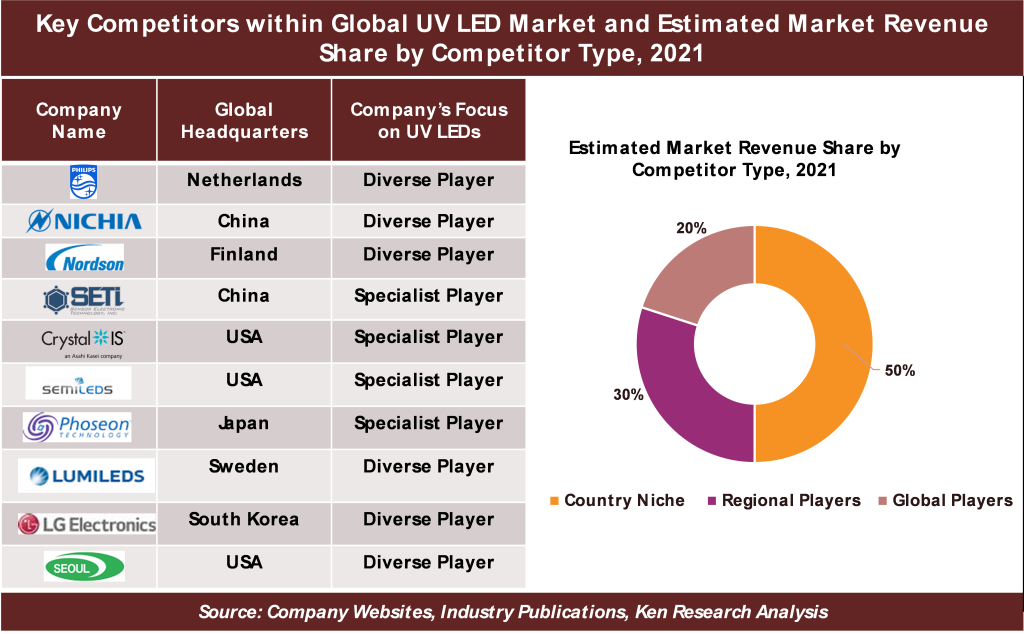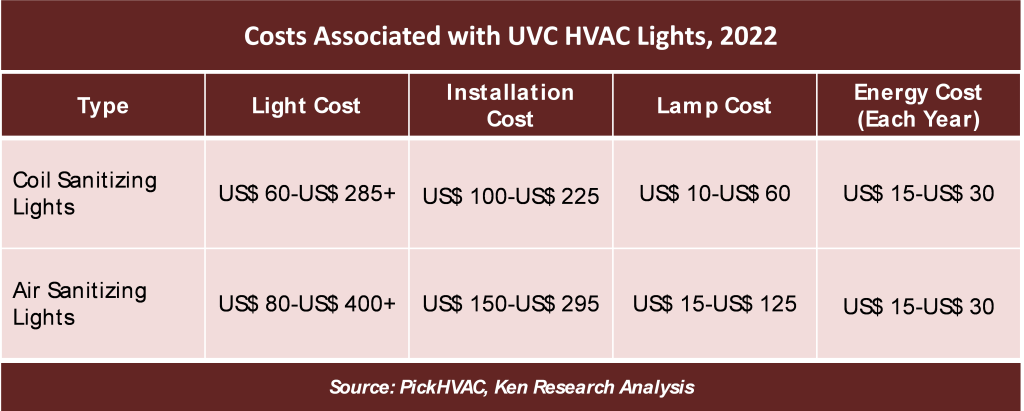Country Niche Players constitute 65% of the Competition, Despite the Presence of about ~500 Competitors Comprising a Large Number of Country-Niche Players, Regional Players, and, Global Players, finds a recent market study on the Global UV LED Market by Ken Research.
UV LEDs are LEDs that emit UV rays and can be used for a variety of applications including DNA gel, spectroscopy, environmental monitoring, banknote identification, disinfection and sterilization, and more. Furthermore, they have a longer operating life and are less hazardous to the environment than traditional mercury UV lamps.
Ken Research shares 3 key insights on the competitive landscape of this dynamic market from its latest research study.
Global Players Constitute ~10% of the Total Number of Competitors, While Country Niche Players Dominate Representing ~65% of Total Competitors.
A comprehensive competitive analysis conducted during The Research Study found that the Global UV LED market is highly competitive with ~500 players, including globally diversified players, regional players, and a large number of country-niche players with their niche in advancements in LED lightening technology, such as DC LED chips, and Li-Fi for variety of applications. The majority of the top global electronics companies, including Koninklijke Philips N.V., Nichia Corporation, Nordson Corporation, and Phoseon Technology, maintained their leading positions in the forecasted period. The majority of players are actively focusing on advancements in UV LEDs technology, including:
- Advances in the packaging technologies of deep ultraviolet light-emitting diodes (UV LEDs) based on aluminum gallium nitride (AlGaN) to inactivate viruses, notably COVID-19.
- Furthermore, the development of UVC LEDs for UV curing is also being pursued by numerous LED semiconductor manufacturers, including ProPhotonix, Excelitas Technologies Corp., Trymax Semiconductor B.V., LED Engin, Inc., and more.
The evolution of deep-UV LEDs has prompted semiconductor manufacturers to intervene, and the need to advance water purification technology through light is steadily increasing due to rising individual concerns regarding water-borne diseases.
Country-Niche Players' and Organizations' Ongoing Efforts to Provide Pharmaceutical Analytical and Bioanalytical Solutions to End-User Industries, Particularly Following the Global Outbreak of the COVID-19 Pandemic, Are Driving Revenue Growth in This Market.
Detailed comparative analysis of key competitors available within the Research Study shows that numerous electronics and semiconductor companies such as Koninklijke Philips N.V., Nichia Corporation, Nordson Corporation, Sensor Electronics Technology, and more are actively focusing on providing a significant number of disinfecting/purifying solutions with advanced technologies that can be used across end-user industries to help in killing viruses and bacteria. Furthermore, numerous companies and organizations are aggressively investing in advanced computation, data analytics, and increased R&D activities.
- In September 2022, Nichia, a Japanese chemical company, unveiled a new high radiant flux UV-C LED to aid in the inactivation and sterilization of multiple microbes in industrial water and air applications.
- In October 2020, Signify, formerly known as Philips Lighting N.V., a Netherland-based company that offers connected LED lighting systems, software, and services launched a residential UV-C tabletop lamp in Asia and the Middle East. The lamp directs UV-C radiation upwards to disinfect the air that circulates between the fixtures and the ceiling.
Increasing Government Energy-Saving Policies and Strategies, along with Rising Investments in Water Infrastructure, Particularly Following the Outbreak of the Covid-19 Pandemic, are Propelling the UV LED Market Growth.
Prior to the COVID-19 pandemic, government-led investment and involvement in water infrastructure, and energy-saving were limited worldwide, with the industry relying primarily on private funding. The pandemic led governments to concede that the structure needed to be changed. Since 2020, several governments across countries have raised funds for clean energy infrastructure to promote clean water and energy-resilient infrastructure that embraces public health. Furthermore, the ongoing COVID-19 pandemic has emphasized the need to develop and demonstrate advanced disinfection technologies, such as UV LEDs for disinfecting or inactivating pathogenic microorganisms, such as viruses, which in turn push governments to take action on implementing the utilization of UV LEDs for to prevent the spread of infections.
- For instance, according to the study conducted by U.S. Food and Drug Administration (US FDA), a U.S. federal agency, on UV Lights and Lamps in 2021, UVC radiation has been confirmed to dismantle the outer protein coating of the SARS-Coronavirus, which, in turn, eventually results in virus inactivation.
- In June 2021, the Canadian government proposed an interim order (IO) under the Pest Control Products Act supporting ultraviolet radiation-emitting devices and ozone-generating devices. In addition, the IO applies to devices used to control, destroy, inactive, or lower the level of human pathogen bacteria, viruses, and other microorganisms.
- In April 2020, Defence Research and Development Organization (DRDO), an Indian government agency, introduced two new products named ‘Automatic Mist Based Sanitizer Dispensing Unit, and ‘UV Sanitization Box and Hand-Held UV Device’ to enable the Covid-19 disinfection process in public places.
- In April 2020, the National Health Commission (NHC), a Chinese government department, issued a guideline mandating all public transportation buses in China to disinfect their interiors and exteriors with UV-C light.
For more information on the research report, refer to the below link:
Global UV LED Market Size, Segments, Outlook, and Revenue Forecast 2022-2028: Ken Research
Follow Us
LinkedIn | Instagram | Facebook | Twitter
Contact Us: –
Ken Research
Ankur Gupta, Head Marketing & Communications
+91-9015378249





